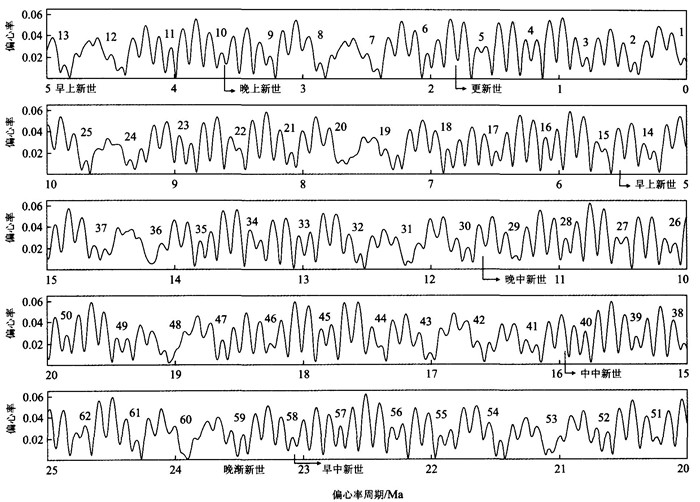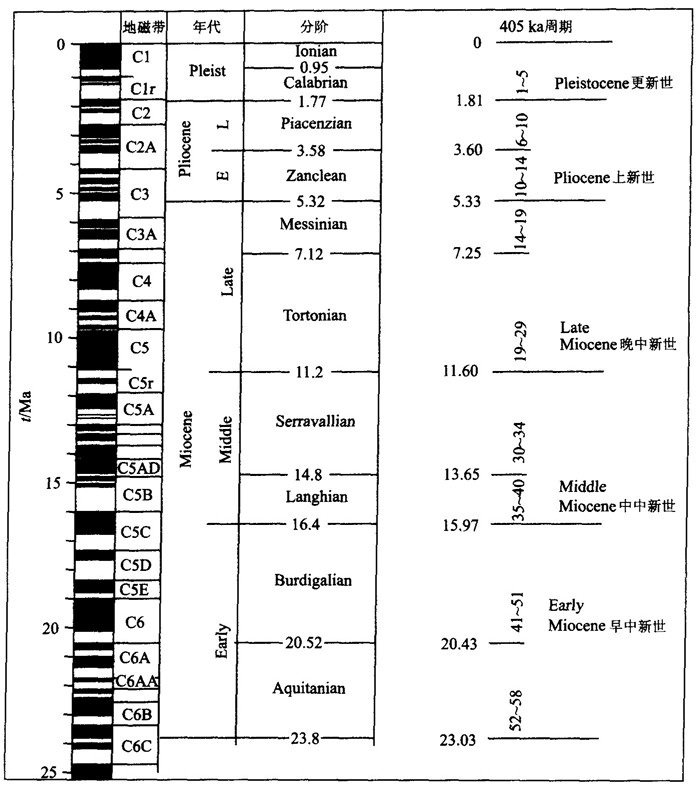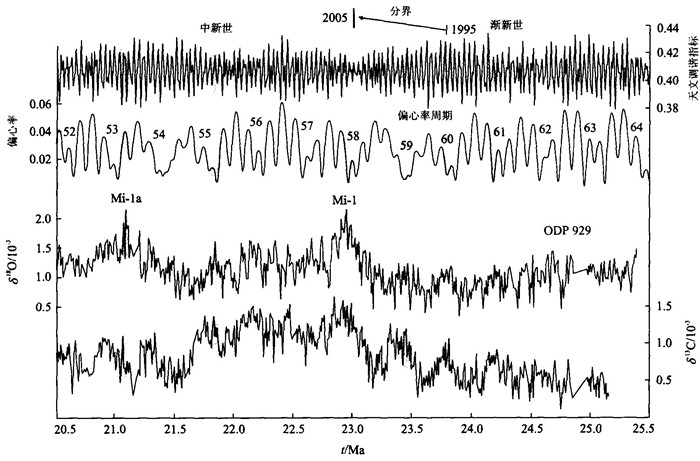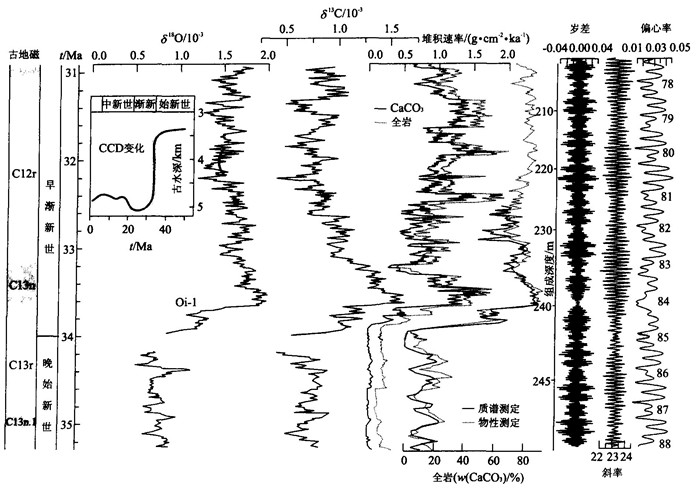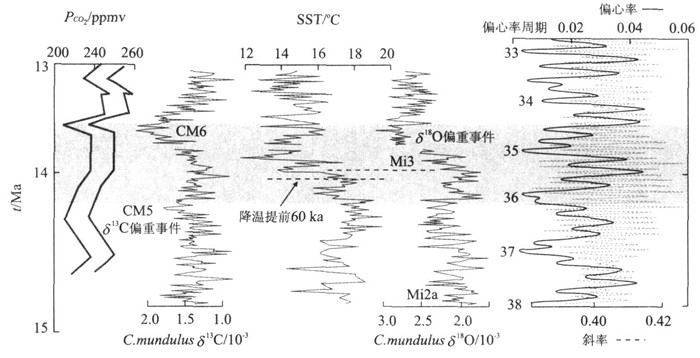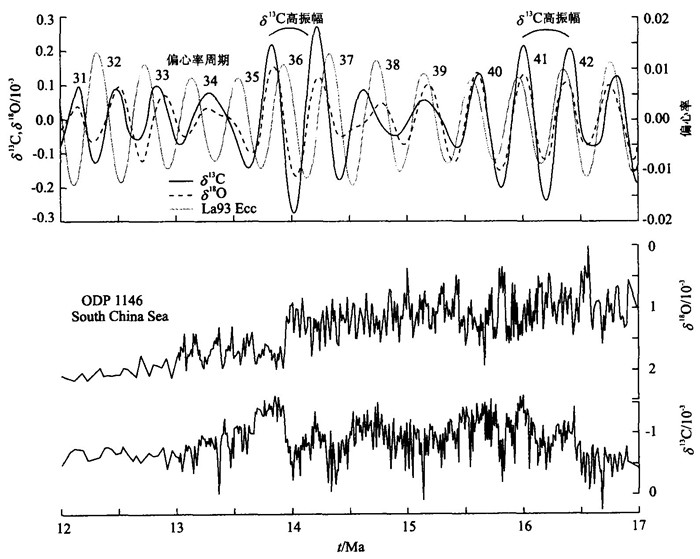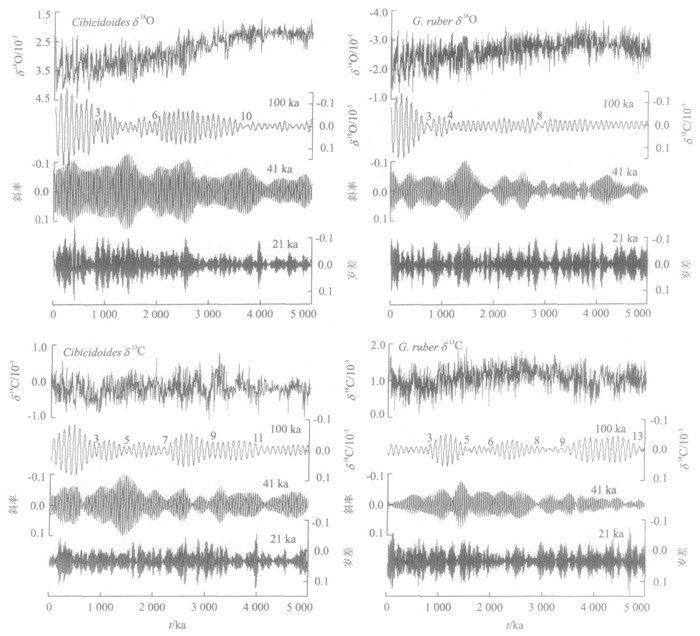Recognizing the Stratigraphic and Paleoclimatic Significance of Eccentricity Cycles
-
摘要: 介绍了偏心率周期在地层和古气候研究方面的新发展.现有地球轨道模式对250Ma以来的轨道运算误差能控制在0.2%之内, 使基于偏心率周期来划分地层年代成为可能.新的国际标准地层年代表以405ka长偏心率周期为基础来划分主要地层界线.新生代将包括E1-E162偏心率长周期, 底界年龄(65.5±0.3) Ma.这一地层年代表的建立, 标志着轨道地层学时代的到来.偏心率的100ka短周期和405ka长周期在诸多地质记录中都有反映, 特别是来自深海钻孔的物理化学古气候指标.很多古气候重大事件往往发生在偏心率周期的弱振幅时期, 表明弱振幅时期易受其他因素的干扰影响, 这些因素包括碳储库、冰盖和海平面变化、电磁场, 以及区域构造重组等等.越来越多的研究发现碳同位素在偏心率周期上与地球轨道驱动相关, 且常领先于氧同位素的变化, 表明热带碳循环过程是影响全球气候变化的关键因素之一.Abstract: This paper introduces some new developments concerning orbital eccentricity in stratigraphic and paleoclimatic studies. The less than 0.2% error in calculating the current orbital model for the last 250 Ma makes possible stratigraphic subdivisions based upon eccentricity cycles. The newly erected international standard chronostratigraphic timescale uses the 405 ka long eccentricity cycles for separating major stratigraphic boundaries, and the Cenozoic Era now comprises E1 to E162 long eccentricity cycles, with the base dated at (65.5±0.3) Ma. The 100 ka and 405 ka eccentricity cycles have been found in many geological records, especially those paleoclimate proxies based upon physiochemical records from deep-sea drilling cores. Many important paleoclimatic events appear to have concurred with weak amplitude periods over the eccentricity band, indicating these periods were likely prone to the influence of such factors as the global carbon reservoir, ice caps, sea level and electromagnetic field, as well as regional tectonic reconfigurations. More and more studies show that the δ13C record is mainly related to orbital forcing over the eccentricity cycles, and its changes often precede δ18O changes, supporting the hypothesis that the carbon cycle is one of the key factors influencing the earth's climate.
-
Key words:
- earth's orbital theory /
- Milankovitch /
- eccentricity cycles /
- orbital stratigraphy /
- paleoclimate change
-
图 1 最近50万年来的δ18O曲线(代表冰盖) 与轨道参数(斜率、偏心率、岁差) 以及6月份日辐射量变化比较(Berger and Loutre, 1991; Hodell et al., 2000)
Fig. 1. The δ18O record over the last 500 ka, compared with orbital elements including obliquity, eccentricity and precession and June insolation at 60°N
图 2 过去250万年包含的1~62偏心率长周期和主要地层界线(Laskar et al., 2004; Gradstein et al., 2005)
Fig. 2. The last 250 Ma includes 1-62 long eccentricity cycles and some major stratigraphic boundaries
图 3 比较1995年和2005年的新近纪地质年代表(Berggren et al., 1995; Lourens et al., 2005)
Fig. 3. Comparison between 1995 and 2005 chronostratigraphic timescales for the Neogene
图 4 热带大西洋ODP929站渐新世/中新世交界底栖δ18O和δ13C的偏重跟偏心率长周期相关(据Paul et al., 2000)
Fig. 4. Increases in the benthicδ18O and δ13C across the Oligocene/Miocene boundary at ODP Site 929 from the tropical Atlantic were related to the long eccentricity cycles
图 5 热带太平洋ODP1218站始新世/渐新世交界底栖δ18O和δ13C、碳酸钙堆积速率和碳酸钙含量的巨大变化, 也与轨道周期相对应, 表明CCD下降和南极冰盖增大, 并且可能伴随全球变冷或者冰盖形成(据Coxall et al., 2005简化)
Fig. 5. The great variations in δ18O and δ13C values, carbonate accumulation rates and CaCO3content across the Oligocene/Miocene boundary at ODP Site 1218 from the tropical Pacific were also related to orbital cycles, indicating a significant drop of CCD and Antarctic ice cap enlargement, probably accompanied also by global cooling and/or ice accumulation on northern hemisphere
图 6 西南太平洋ODP1171站底栖δ18O、δ13C以及Mg/Ca比值求得的表层水温变化与偏心率周期和全球CO2含量的关系, 表明中中新世气候转型时降温约6~7 ℃, 比南极冷水圈增长提前约6万年(Shevenell et al., 2004)
Fig. 6. Comparisons between the benthic δ18O and δ13C and the Mg/Ca-derived SST from ODP Site 1171 in the southwestern Pacific and eccentricity cycles and the globalPco2, indicating a drop of SST by 6-7 ℃ which was about 60 ka prior to the Antarctic cryosphere expansion during the Middle Miocene climate transition
图 7 南海北部ODP1146站中中新世底栖δ18O和δ13C在偏心率长周期的滤波结果表示明显不同步始于15~14百万年间(Holbourn et al., 2004)
Fig. 7. Filtered eccentricity signal components in benthic δ18O and δ13C from ODP Site 1146 in the northern South China Sea show obvious discrepancies starting from 15-14 Ma
图 8 南海南部ODP1143站过去5百万年来的底栖有孔虫Cibicidoides和浮游有孔虫Globigerinoides ruber δ18O与δ13C在偏心率、斜率和岁差周期上的滤波结果, 表明偏心率周期在这些气候记录上明显的不连续性(田军等, 2004)
Fig. 8. Filtered orbital signal components in benthic and planktonic δ18O and δ13C from ODP Site 1143 in the southern South China Sea over the eccentricity, obliquity and precession bands, showing the distinctive discontinuity of the eccentricity cycles from these climate records
-
Beaufort, L., 1994. Climatic importance of the modulation of the 100 kyr cycle inferred from 16m. y. long Miocenerecords. Paleoceanography, 9: 821-834. doi: 10.1029/94PA02115 Berger, A., 1977. Support for the astronomical theory of cli-matic change. Nature, 269: 44-45. doi: 10.1038/269044a0 Berger, A., Imbrie, J., Hays, J. D., 1984. Milankovitch and climate. Reidel Publishing, Dordrecht. Berger, A., 1988. Milankovitch theory and climate. Review of Geophysics, 26 (4): 624-657. doi: 10.1029/RG026i004p00624 Berger, A., Loutre, M. F., 1991. Insolation values for the cli-mate of the last 10 million years. Quat. Sci. Rev., 10: 297-317. doi: 10.1016/0277-3791(91)90033-Q Berger, A., Li, X. S., Loutre, M. F., 1999. Modeling north-ern hemisphere ice volume over the last 3 Ma. Quat. Sci. Rev., 18: 1-11. doi: 10.1016/S0277-3791(98)00033-X Berger, A., Loutre, M. F., Laskar, J., 1992. Stability of the astronomical frequencies over the earth's history for pa-leoclimate Studies, 255: 560-566. doi: 10.1126/science.255.5044.560 Berger, W. H., Bickert, T., Jansen, E., et al., 1993. The cen-tral mystery of the Quaternary ice age. Oceanus, 36: 53-56. Berger, W. H., Jansen, E., 1994. Mid-Pleistocene climate shift—The Nansen connection. Geophys. Monogr., 84: 295-311. Berggren, W. A., Kent, D. V., Swisher, C. C., et al., 1995. A revised Cenozoic geochronology and chronostratigra-phy. In: Berggren, W. A., Kent, D. V., Aubry, M. P., et al., eds., Geochronology, time scales and global strati-graphic correlation. SEPMS pecial Publication, 54: 129-212. Clemens, S. C., Tiedemann, R., 1997. Eccentricity forcing of Pliocene-Early Pleistocene climate revealed in a marine oxygen-isotope record. Nature, 385: 801-804. doi: 10.1038/385801a0 Coxall, H. K., Wilson, P. A., Pälike, H., et al., 2005. Rapid stepwise onset of Antarctic glaciation and deeper calcite compensation in the Pacific Ocean. Nature, 433: 53-57. doi: 10.1038/nature03135 Gradstein, F., Ogg, J., Smith, A., 2005. A geologic time scale 2004. Cambridge University Press, London. Hays, J. D., Imbrie, J., Shackleton, N. J., 1976. Variations of the earth's orbit: Pacemaker of the ice age. Science, 194: 1121-1132. doi: 10.1126/science.194.4270.1121 Hodell, D. A., Charles, C. D., Ninnemann, U. S., 2000. Com-parison of interglacial stages in the South Atlantic sec-tor of the southern ocean for the past 450 kyr: Implica-tions for marine isotope stage MIS 11. Global and Plan-etary Change, 24: 7-26. doi: 10.1016/S0921-8181(99)00069-7 Holbourn, A., Kuhnt, W., Schulz, M., 2004. Orbital paced climate variability during the Middle Miocene: High res-olution benthic foraminiferal stable-isotopic records from the tropical western Pacific. In: Clift, P., Wang, P., Kuhnt, W., etal., eds., Continent-ocean interac-tions within East Asian marginal seas. Geophysical Monograph, 149: 321-337. Imbrie, J., Boyle, E., Clemens, S., et al., 1992. On the struc-ture and origin of major glaciation cycles. 1. Linear re-sponses to Milankovitch forcing. Paleoceanography, 7: 701-738. Imbrie, J., Imbrie, K. P., 1979. Ice ages: Solving the mystery. Harvard University Press, MA. Imbrie, J., Berger, A., Boyle, E., et al., 1993. On the struc-ture and origin of major glaciation cycles. 2. TThe 100000-year cycle. Paleoceanography, 8: 699-735. Imbrie, J., Hays, J. D., Martinson, D. G., et al., 1984. The orbital theory of Pleistocene climate: Support from a re-vised chronology of the marine δ18O record. In: Berger, A., Imbrie, J., Hays, J. D., et al., eds., Milankovitch and climate. Part1. Reidel Publishing Co., Dordrecht, 269-305. Krijgsman, W., Hilgen, F. J., Raffi, I., et al., 1999. Chronol-ogy, causes and progression of the Messinian salinity crisis. Nature, 400: 652-655. doi: 10.1038/23231 Laskar, J., Robutel, P., Joutel, F., et al., 2004. A long term numerical solution for the insolation quantities of the earth. Astron. Astrophys., 428: 261-285. doi: 10.1051/0004-6361:20041335 Lourens, L. J., Wehausen, R., Brumsack, H. J., 2001. Geo-logical constraints on tidal dissipation and dynamical el-lipticity of the earth over the past three million years. Nature, 409: 1029-1033. doi: 10.1038/35059062 Lourens, L. J., Hilgen, F. J., Shackleton, N. J., et al., 2005. The Neogene period. In: Gradstein, F., Ogg, J., Smith, A., eds., A geologic time scale 2004. Cambridge University Press, London. Paul, H. A., Zachos, J. C., Flower, B. P., et al., 2000. Orbit-ally induced climate and geochemical variability across the Oligocene/Miocene boundary. Paleoceanography, 15: 471-485. doi: 10.1029/1999PA000443 Rutherford, S., DHondt, S., 2000. Early onset and tropical forcing of 100000-year Pleistocene glacial cycles. Nature, 408: 72-75. Shackleton, N. J., 2000. The 100000-year ice-age cycle iden-tified and found to lag temperature, carbon dioxide and orbital eccentricity. Science, 289: 1897-1902. doi: 10.1126/science.289.5486.1897 Shevenell, A. E., Kennett, J. P., Lea, D. W., 2004. Middle Miocene Southern Ocean cooling and Antarctic cryo-sphere expansion. Science, 305: 1766-1770. doi: 10.1126/science.1100061 Sierro, F. J., Flores, J. A., Zamarreno, I., et al., 1999. Messinian pre-evaporite sapropels and precession-induced oscillation in western Mediterranean climate. Mar. Geol., 153: 137-146. doi: 10.1016/S0025-3227(98)00085-1 Tian, J., Wang, P. X., Cheng, X. R., 2004. Responses of fo-raminiferal isotopic variations at ODP Site 1143 in the southern South China Sea to orbital forcing. Science in China (Ser. D), 47 (10): 943-953. Tiedemann, R., Sarnthein, M., Shackleton, N. J., 1994. As-tronomic timescale for the Pliocene Atlantic δ18O and dust flux records from Ocean Drilling Program Site 659. Paleoceanography, 9: 619-638. doi: 10.1029/94PA00208 VanVugt, N., Langereis, C. G., Hilgen, F. J., 2001. Orbital forcing in Pliocene-Pleistocene Mediterranean lacustrine deposits; dominant expression of eccentricity versus precession. Palaeogeogr., Palaeoclimatol., Palaeo-ecol., 172: 193-205. doi: 10.1016/S0031-0182(01)00270-X Wade, B. S., Pälike, H., 2004. Oligocene climate dynamics. Paleoceanography, 19: PA4019. doi: 10.1029/2004PA001042. Wang, P. X., Tian, J., Cheng, X. R., et al., 2003. Exploring cyclic changes of the ocean carbon reservoir. Chinese Sci. Bull., 48 (23): 2536-2548 (in Chinese). doi: 10.1360/03wd0155 Zachos, J. C., Pagani, M., Sloan, L., et al., 2001. Trends, rhythms, and aberrations in global climate 65 Ma to present. Science, 292: 686-693. doi: 10.1126/science.1059412 田军, 汪品先, 成鑫荣, 2004. 南沙ODP1143站有孔虫同位素变化对地球轨道驱动的响应. 中国科学(D辑), 34 (5): 452-460. https://www.cnki.com.cn/Article/CJFDTOTAL-JDXK200405007.htm 汪品先, 田军, 成鑫荣, 等, 2003. 探索大洋碳储库的演变周期. 科学通报, 48 (23): 2536-2548. https://www.cnki.com.cn/Article/CJFDTOTAL-KXTB200321003.htm -









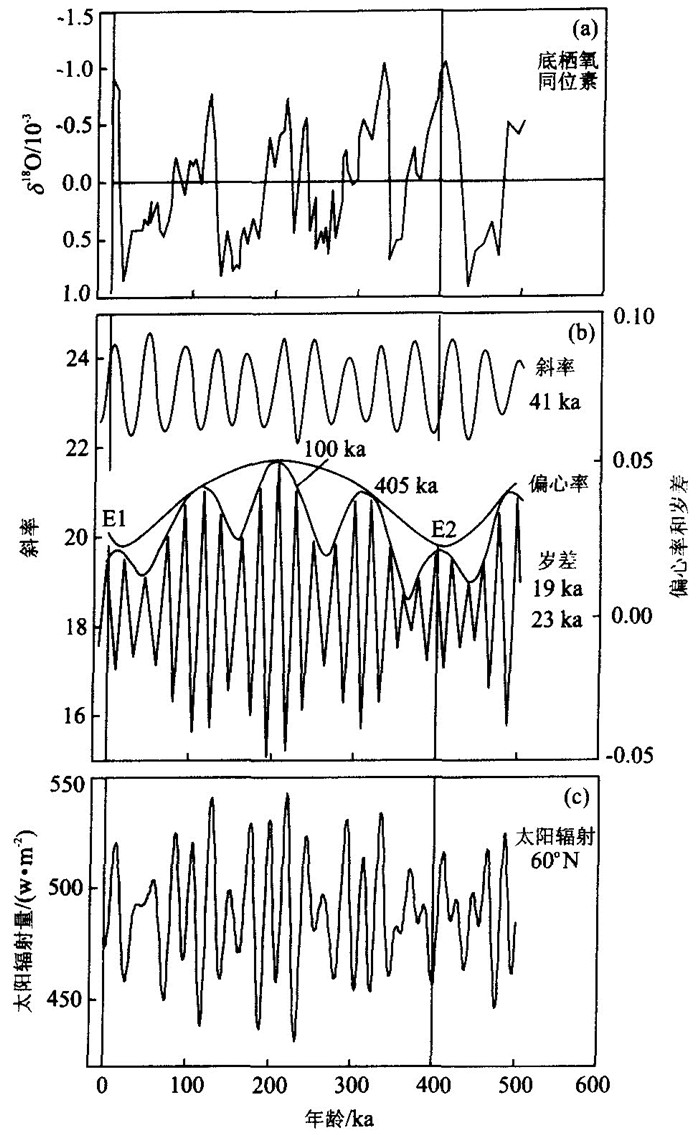
 下载:
下载:
